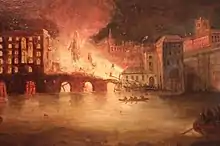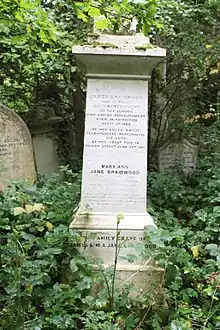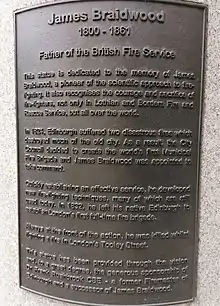James Braidwood
James Braidwood (1800–1861) was a Scottish firefighter who founded one of the world's first municipal fire service in Edinburgh in 1824. He was the first director of the London Fire Engine Establishment (the brigade which was eventually to become the London Fire Brigade).[1] He is credited with the development of the modern municipal fire service.[2]

Career
He was born in Edinburgh the tenth child of Janet Mitchell and Francis James Braidwood, a cabinetmaker. He was educated at the Royal High School. He learned about the construction of buildings after joining his father's building firm as an apprentice, knowledge he was later to put to good use.

Appointed Master of Fire Engines at the age of 24, two months prior to the Great Fire of Edinburgh, Braidwood established principles of fire-fighting that are still applied today. His training as a surveyor gave him exceptional knowledge of the behaviour of building materials and housing conditions in the Old Town of Edinburgh. He recruited to the service expert tradesmen – slaters, carpenters, masons and plumbers – who could apply their various fields of expertise to fire fighting. He also recruited experienced mariners for an occupation that required heavy manual work in hauling engines and trundling wheeled escape ladders up and down Edinburgh's steep streets, as well as nimble footwork when negotiating rooftops and moving through partially destroyed buildings. His many original ideas of practical organisation and methodology, published in 1830, were adopted throughout Britain. He was, however, resistant to the introduction of steam-driven engines. In 1833 he left Edinburgh to lead the London Fire Engine Establishment. The London Fire Engine Establishment had to fight a blaze at the Palace of Westminster, on 16 October 1834, that destroyed almost all of the Palace.
Braidwood was distinguished for his heroism on the occasion of great fires in Edinburgh (1824) and London (1830). He also undertook a pastoral role, introducing visits to ordinary firemen and their families by the London City Mission.
As a strange curiosity, Braidwood was the first witness at the trial of William Burke of Burke and Hare fame. He gave evidence on Christmas Eve of 1828, in his capacity as an Edinburgh builder, who had been commissioned by the authorities to draw scale plans of the notorious lodging house on Tanners Close where the murders took place. His evidence was simply to state that the plans were an accurate representation of the building.[3]
Death


On 22 June 1861 he died in the Tooley Street fire at Cotton's Wharf near London Bridge station when a falling wall crushed him, three hours after the fire began.[4] It took two days to recover his body and his heroism led to a massive funeral on 29 June where his funeral cortege stretched 1.5 miles (2.4 km) behind the hearse, a public spectacle equal almost to the Tooley Street fire.[5] The fire, which continued to burn for a fortnight, caused damage valued at £2,000,000, equivalent to £188,000,000 in 2019. A London fireboat was named in his honour in the 1930s.
Braidwood is buried at Abney Park Cemetery, Stoke Newington, London, not far from the Stoke Newington Fire Station. The grave lies on a path edge towards the south, rendering it relatively easy to see in this congested and overgrown cemetery. His wife, Mary Ann Jane Braidwood (1806–1871) was buried with him.
The grave was long lost to public view and in 1981, following much research by the then Stoke Newington Fire Station White Watch Station Officer, Liam Hackett, the precise location of the grave was found. Hackett then spent the rest of the Summer clearing the site and restoring the lettering on the monument.[6]
Legacy
National memorial

The death of James Braidwood, whilst engaged in fire fighting duties, is recorded on the National Firefighters Memorial which is located adjacent to St Paul's Cathedral in the City of London.
Freemason Lodge
A group of former London Firefighters decided to form a new Masonic Lodge. They chose to remember the life and death of this famous fireman by naming the Lodge after him. Consecrated in 2005 this is now known as the Braidwood Lodge Number 9802 in the Province of West Kent.
Republished fire manual
Recognising the lack of publications on fire engines in the English language, Braidwood published what is regarded as one of the first text books on the science of fire engineering in 1830: On the Construction of Fire Engines and Apparatus.[7] Although many historical (Public domain) books often are re-published, Braidwood's book was officially re-published as a second edition in 2004. Braidwood also authored Fire prevention and fire extinction,[8] published posthumously in 1866.
New memorial

On 5 September 2008, the James Braidwood memorial statue in Parliament Square, Edinburgh was unveiled by Professor Sir Timothy O'Shea, Principal of the University of Edinburgh.[9] A fund had been established for a £75,000 memorial to Braidwood, to be created by the Glasgow sculptor, Kenneth Mackay, led by Dr Frank Rushbrook CBE, 93-year-old former Firemaster at Lothian & Borders Fire Brigade. The statue stands around the corner from the site of the original main fire station in the High Street. The bronze plaque below it reads:
James Braidwood
1800 – 1861
Father of the British Fire ServiceThis statue is dedicated to the memory of James Braidwood, a pioneer of the scientific approach to fire-fighting. It also recognises the courage and sacrifice of fire-fighters, not only in Lothian & Borders Fire and Rescue Service, but all over the world.
Dr Rushbrook was also the benefactor of the Fire Laboratory that lies at the heart of the BRE Centre for Fire Safety Engineering, in the School of Engineering at the University of Edinburgh. His gift was motivated by a desire to promote education in applied fire science, and is routinely used for experimental classes on the undergraduate and taught postgraduate fire programmes at the University, together with PhD/post-doctoral research and also on occasion by fire service personnel. The laboratory was officially opened in 2003, and has since been expanded to two floors.
References
- "London Fire Brigade website". London Fire Brigade. 30 April 2008. Retrieved 18 January 2013.
- The foundations of the modern fire service, Gloucestershire Fire and Rescue Service
- The Infamous Burke and Hare: Serial Killers and Resurrectionists of 19th Century Edinburgh, by R. Michael Gordon p. 103 ISBN 978-0-7864-4403-8
- "Tooley Street Fire". London Fire Brigade. Archived from the original on 17 January 2013. Retrieved 18 January 2013.
- "University of Edinburgh's profile of James Braidwood". Scottish-places.info. Retrieved 18 January 2013.
- Wood Paul. James Braidwood First Chief officer Of The London Fire Brigade.Roundthreads Magazine. Issue No 19. 2015 Summer Edition Page 8. Retrieved 12 May 2017 Archived 26 April 2016 at the Wayback Machine
- Braidwood, James (1830). On the Construction of Fire Engines and Apparatus by James Braidwood, 2nd edition, 2004. Preface by Brian Allaway. Retrieved 18 January 2013.
- Fire prevention and fire extinction. Bell and Daldy. 1866. Retrieved 18 January 2013 – via Internet Archive.
- "'No bells and no whistles for 'father of firefighting'". The Scotsman. 26 July 2008. Retrieved 18 January 2013.
- Attribution
 This article incorporates text from a publication now in the public domain: Wood, James, ed. (1907). "Braidwood, James". The Nuttall Encyclopædia. London and New York: Frederick Warne.
This article incorporates text from a publication now in the public domain: Wood, James, ed. (1907). "Braidwood, James". The Nuttall Encyclopædia. London and New York: Frederick Warne. This article incorporates text from a publication now in the public domain: "Braidwood, James". Dictionary of National Biography. London: Smith, Elder & Co. 1885–1900.
This article incorporates text from a publication now in the public domain: "Braidwood, James". Dictionary of National Biography. London: Smith, Elder & Co. 1885–1900.
External links
- Works by James Braidwood at Project Gutenberg
- Works by or about James Braidwood at Internet Archive
- 'Scotsman' newspaper obituary for Dr Frank Rushbrook (2014)
- Wood Paul. James Braidwood First Chief Officer Of The London Fire Brigade. Roundthreads Magazine.Issue No 19.2015 Summer Edition Page 8. Archived 26 April 2016 at the Wayback Machine
